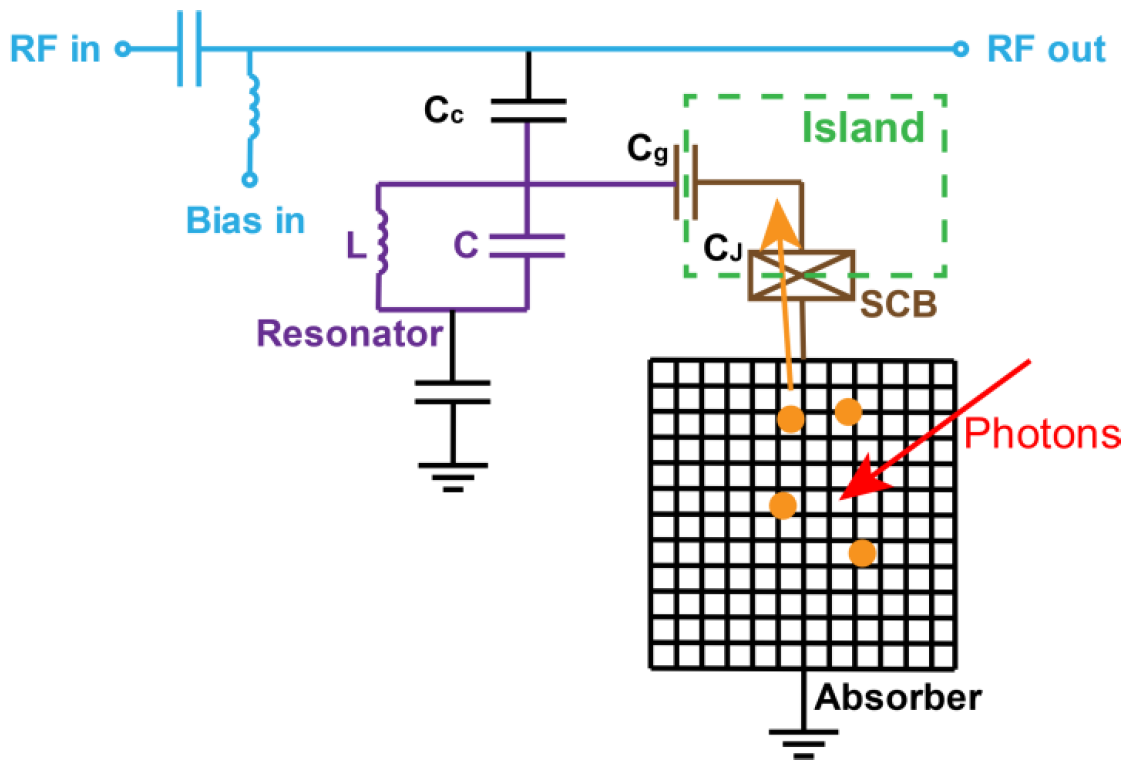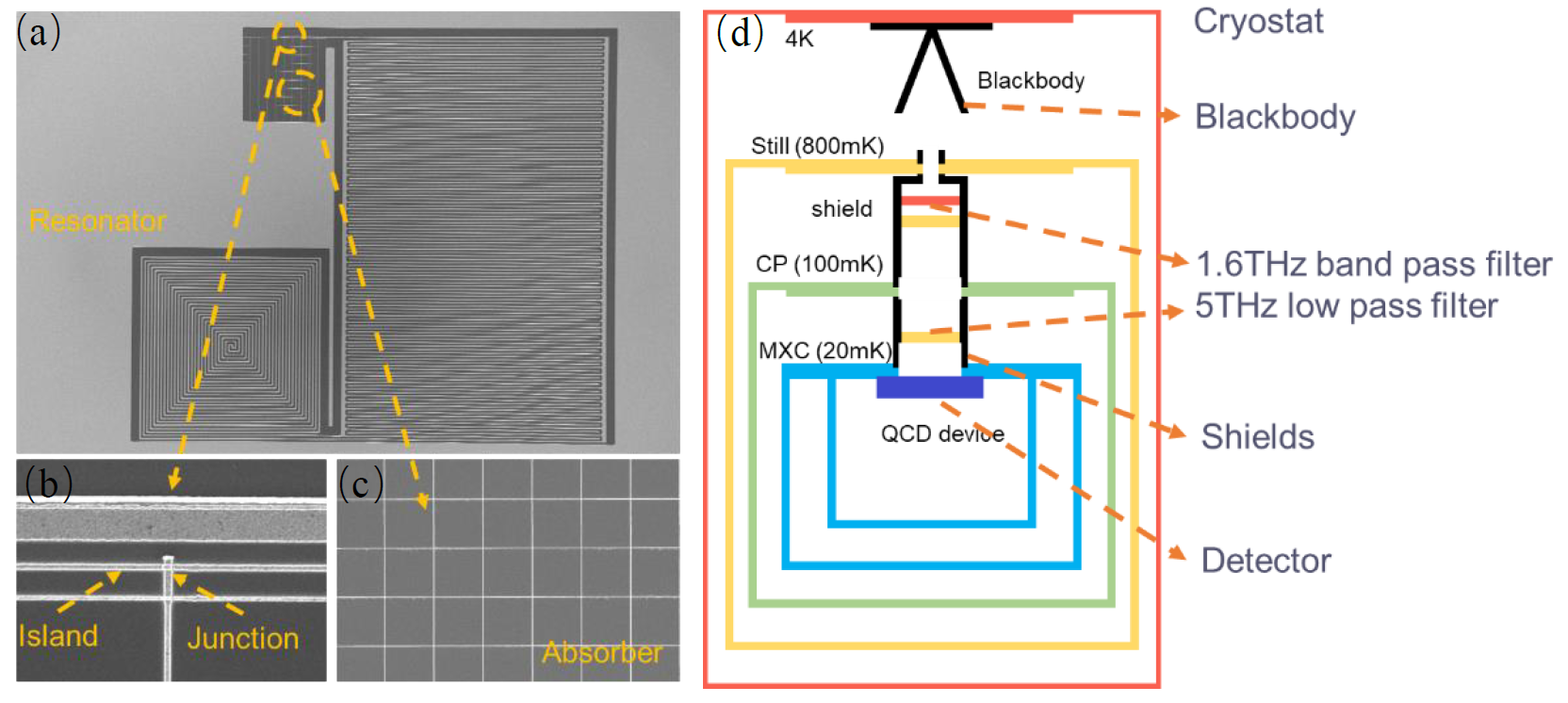| PREVIOUS PRESENTATION | BACK TO PROGRAM OVERVIEW | NEXT PRESENTATION |
Sensitive Superconducting Quantum Capacitance Detectors at Terahertz Wavebands
T. Y. Chi1, L. L. Shi1, R. F. Su1, S. M. Zhan1, S. Y. Yao1, X. C. Tu1,2, J. B. Wu1,2, B. B. Jin1,2, J. Chen1,2,*, and P. H. Wu1,2
1Research Institute of Superconductor Electronics (RISE), School of Electronic Science and Engineering, Nanjing University, Nanjing, 210023, China
2Purple Mountain Laboratories, Nanjing 211111, China
*chenj63@nju.edu.cn
Superconducting quantum capacitance detectors (QCDs) are ultra-sensitive direct detectors at terahertz (THz) wavebands. [1] A QCD contains a superconducting RF resonator, a single cooper pair box (SCB) called a charge qubit, and a THz absorber, see Figure 1. The THz absorber will absorb THz photons and generate lots of quasiparticles. Then the quasiparticles will tunnel into the island of SCB under a suitable DC bias voltage. This event will change the capacitance of the SCB, which we call quantum capacitance. Further, this change will shift the resonator’s resonant frequency and can be read out by a homodyne detection. QCDs can be integrated to large-scale imaging chips because their signals can be read out by one transmission line. Meanwhile, QCDs have very high sensitivity. The reported noise equivalent power (NEP) of QCDs can reach 10-20 W/Hz1/2, making them one of the most sensitive THz detectors. Because of the ultra-high sensitivity and the ability to integrate at a large scale, QCDs are expected to be used in the next generation of space telescopes and so on.

Figure 1: Schematic of QCD. A QCD is composed of an RF resonator (purple solid line), an SCB (brown solid line) containing a small Josephson junction and a capacitor, and a THz absorber (black grid). The green dash rectangle surrounds the superconducting electrode (also called “island”). The Blue part is the RF readout transmission line with DC bias part.
We have designed and fabricated QCDs and characterized them with a homemade system. The system contains a homemade blackbody at low temperature as a weak THz radiation source, a stack of filters to get a narrow band of radiation around 1.6 THz, and a set of shields to shield stray radiation, see Figure 2(d). QCDs are placed in a dilution refrigerator (cryostat) and work down to 20 mK. The homemade blackbody’s radiation power is controlled by a computer and its temperature can vary from 3.5 K to 40 K. We designed and fabricated a lumped RF resonator composed of an interdigitated capacitor and a double helix inductor, see Figure 2(a). The resonator is fabricated by tantalum (Ta) film with 200 nm thickness. The intrinsic quality factor (Qi) is more than 3×106 mostly. The SCB is fabricated by aluminum (Al) with the double-angle evaporation process.
The Josephson junction is very small which is 100 nm × 100 nm in size. To couple the THz radiation, we designed a mental grid THz absorber whose absorbance is close to the intrinsic value of 50%. Under the above preparation condition, we have observed the periotic response of the QCD at the bath temperature of 20 mK, which agrees with the expected SCB signal controlled by the bias voltage. We also observed the amplitude decrease with the blackbody’s radiation power increase. This is the response of the QCD to THz radiation. For limited sensitivity detection, the detector’s NEP should be lower than the photon background NEP, which is about 5×10-18 W/Hz1/2 for 1.6 THz.[2] Our fabricated QCD’s NEP is better than 10-18 W/Hz1/2.

Figure 2: Photos of the QCD and the characterization system. (a) are QCD’s SEM pictures. The enlarged images (b) and (c) are the SCB and the THz absorber, respectively. The size of Josephson junction is about 100 nm × 100 nm. (d) is the schematic of the dilution refrigerator and homemade system.
THz single photon detection (SPD) is very difficult, because of the lower photon energy and the lack of THz single photon radiation source. For a higher counting rate, the detector’s NEP should be better than 10-20 W/Hz1/2. [2] However, QCD’s ultra-high sensitivity is good enough to achieve THz SPD. In the future, we will continue to raise the Qi of the resonator and optimize the SCB’s quality to improve the sensitivity of the detector and achieve THz SPD. We will also try to fabricate a larger-scale QCD chip to implement THz multiplex imaging and so on.
References
[1] P. M. Echternach, Single photon detection of 1.5 THz radiation with the quantum capacitance detector. Nature Astronomy 2(1), 90–97, 11, 2017.
[2] D. Farrah, et al. Review: far-infrared instrumentation and technological development for the next decade. J. Astron. Telesc. Instrum. Syst. 5(2), 1, 2019.
